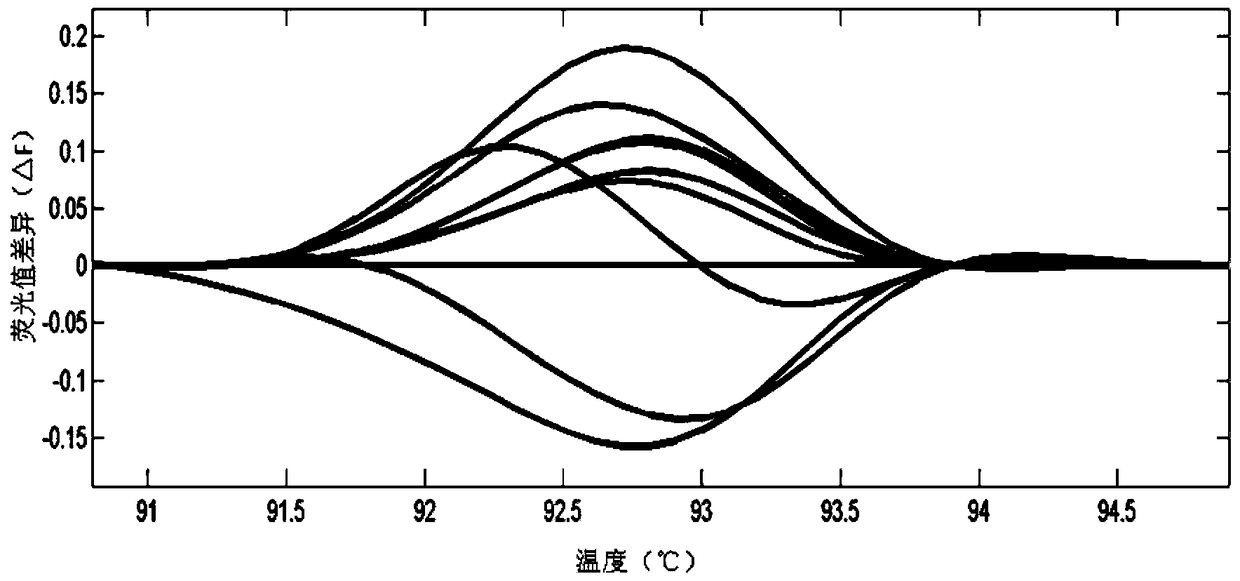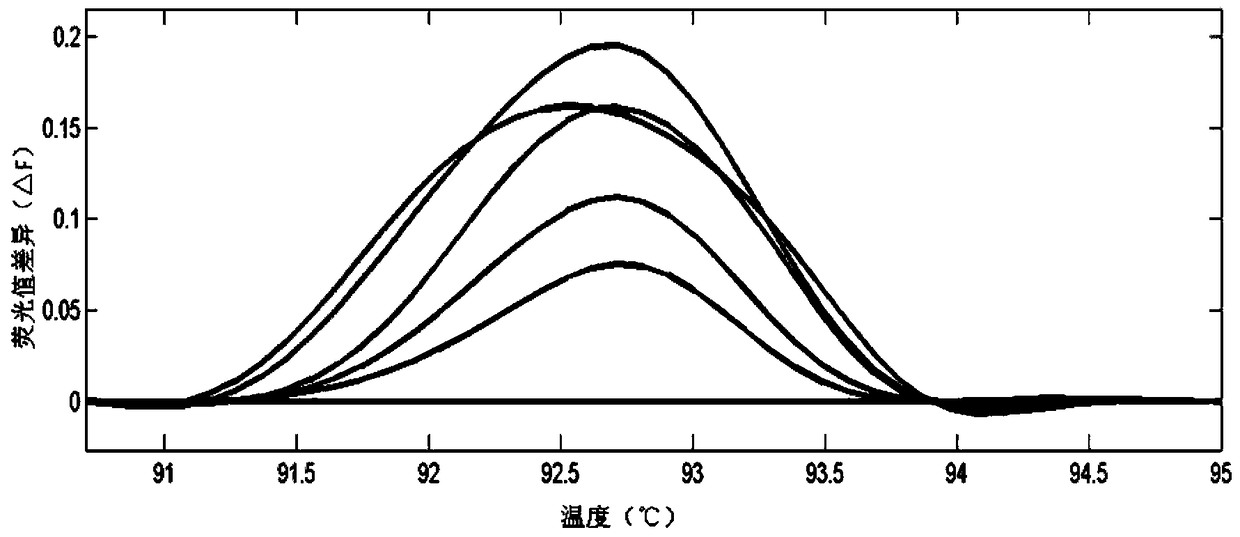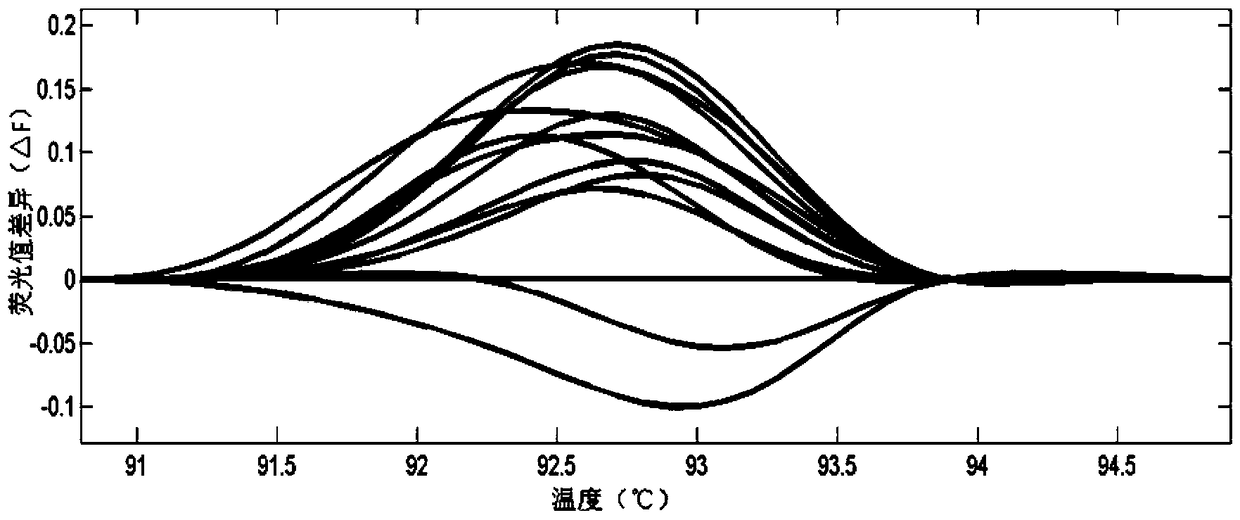A method for screening rice targeted gene edited plants
A technology for targeting genes and plants, applied in the field of plant genetic engineering, can solve problems such as poor sensitivity, lack of single-plant identification methods, false positives, etc., and achieve the effects of simple and fast operation, improved plant screening efficiency, and high accuracy.
- Summary
- Abstract
- Description
- Claims
- Application Information
AI Technical Summary
Problems solved by technology
Method used
Image
Examples
Embodiment 1
[0080] The above-mentioned population of CRISPR-targeted editing of the rice LOC_Os03g55240 gene is the test plant, and the unedited rice plant is the control plant. The steps to detect and screen the plants to be tested are as follows:
[0081] 1. Extraction of rice genomic DNA
[0082] (1) The rice leaves are cut into pieces and placed in a 2.0mL centrifuge tube, and a steel ball is placed at the same time, and ground with a tissue mill;
[0083] (2) Add 800 μL CTAB extraction buffer (Tris-HCl, 100 mM, pH 8.0; EDTA, 20 mM, pH 8.0; NaCl, 500 mM; CTAB, 2%), water bath at 65°C for 40 min, and shake 3-4 times during this period;
[0084] (3) add an equal volume of chloroform-isoamyl alcohol mixed solution (wherein the volume ratio of chloroform and isoamyl alcohol is 24:1), invert up and down and mix, and centrifuge at 10000r / min for 10min;
[0085] (4) Transfer the supernatant to a new 1.5mL centrifuge tube, add an equal volume of isopropanol pre-cooled at -20°C, gently invert ...
Embodiment 2
[0102] The plants to be tested are detected and screened using the same method as in Example 1, the difference is only that the PCR amplification steps are different, and the details are as follows:
[0103] The PCR primer pairs adopted in this example are as follows:
[0104] Upstream primer B2F: 5'-TCACCGAGCACGACGTGACCTT-3'; (SEQ ID NO:6)
[0105] Downstream primer B2R: 5'-CACGCTGAGGGAGACCTCGAACA-3'; (SEQ ID NO:7)
[0106] It was synthesized by Shanghai Sangon Bioengineering Co., Ltd.
[0107] The PCR amplification reaction system is as follows: rTaq, 0.2 μL; 2×GC buffer, 5 μL; 2.5mix dNTPs, 1.6 μL; 10 μM upstream primer B2F, 0.2 μL; 10 μM downstream primer B2R, 0.2 μL; 10×Eva Green (fluorescence dye), 1 μL; 50 ng / μL DNA, 1 μL; sterile water 1.3 μL; mineral oil 10-20 μL.
[0108] The PCR reaction program was: pre-denaturation at 94 °C for 5 min; denaturation at 94 °C for 30 s, annealing at 58 °C for 30 s, extension at 72 °C for 30 s, a total of 40 cycles; extension at 72 ...
Embodiment 3
[0151] The population of the above-mentioned large spot gene LOC_Os12g16720 CRISPR-targeted editing is the test plant, and the unedited rice plant is the control plant. The steps to detect and screen the plants to be tested are as follows:
[0152] 1. Extraction of rice genomic DNA
[0153] (1) The rice leaves are cut into pieces and placed in a 2.0mL centrifuge tube, and a steel ball is placed at the same time, and ground with a tissue mill;
[0154] (2) Add 800 μL CTAB extraction buffer (Tris-HCl, 100 mM, pH 8.0; EDTA, 20 mM, pH 8.0; NaCl, 500 mM; CTAB, 2%), water bath at 65°C for 40 min, and shake 3-4 times during this period;
[0155] (3) add an equal volume of chloroform-isoamyl alcohol mixed solution (wherein the volume ratio of chloroform and isoamyl alcohol is 24:1), invert up and down and mix, and centrifuge at 10000r / min for 10min;
[0156] (4) Transfer the supernatant to a new 1.5mL centrifuge tube, add an equal volume of isopropanol pre-cooled at -20°C, gently in...
PUM
 Login to View More
Login to View More Abstract
Description
Claims
Application Information
 Login to View More
Login to View More - R&D
- Intellectual Property
- Life Sciences
- Materials
- Tech Scout
- Unparalleled Data Quality
- Higher Quality Content
- 60% Fewer Hallucinations
Browse by: Latest US Patents, China's latest patents, Technical Efficacy Thesaurus, Application Domain, Technology Topic, Popular Technical Reports.
© 2025 PatSnap. All rights reserved.Legal|Privacy policy|Modern Slavery Act Transparency Statement|Sitemap|About US| Contact US: help@patsnap.com



